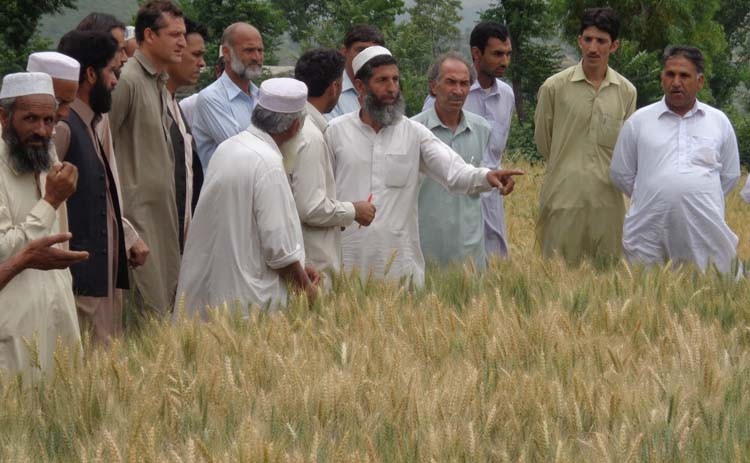
Numerous short- and long-term policy measures need to be taken to ensure agriculture growth and stability

Following the federal government, the Punjab government has made agriculture one of its top priorities. It has done so by allocating a huge chunk of money to the sector in many forms. With an endowment of a whopping Rs100 billion, to be spent over the course of two years, the ‘Kissan Package’ is an ambitious plan to aid the already crushed farmers across the province.
The question is would this relief package actually rescue farmers? Even if it does, is it a long-term solution to the issues being faced today? Thirdly, would the policy measures taken at this point in time avert future crises that may be upon the farmers?
With the introduction of the Kissan Package this year, the Punjab government has shown a shift in attitude and displayed a renewed ‘commitment’ to addressing the issues of farmers and rural areas.
A very basic issue that has been overlooked in both the federal and provincial budget for Punjab is that it has concentrated greatly on supply side policies. Supply side policies ensure increased production, food security and self-sufficiency in crops. However, does increasing a farmer’s yield make the profession more profitable? Unfortunately, not necessarily. By over-producing than the demand for a certain commodity, a market disequilibrium is created. In this case it causes excess supply. Such a situation pushes prices down as producers become price takers and in turn end up making losses.
Another issue of dire importance is the proposed water subsidy. By giving a subsidy on tubewell energy, the government will not only be leading the farmers to their own deaths but also be leading the country onto a track of chaos at a much faster pace. The misuse and overuse of tubewell connections and tubewells themselves have serious implications for the country’s resources. Tubewell connections are used for purposes beyond pumping water i.e domestic uses. Similarly, with a subsidy, farmers will now use and overuse their tubewells, further depleting the ground water tables of an already water scarce country. Water is a necessity of life and its evident scarcity would lead to chaos amongst the masses and bring imminent ruin upon farmers.
The provision for crop and land insurance is a good step taken. However, it should not have been limited to just two crops, rather it should be introduced at a much larger scale; it should include every single crop being grown in the province. In order to make it sustainable and self-sufficient, it should be operated and managed like any other insurance scheme for any other commodity. This would most certainly prove to be a very popular policy amongst the rural masses.
There still seems to be little attention being given to agro-finance and loans. The interest rates remain horrendously high, with terms having implications beyond a regular farmer’s comprehensive ability. The truth is our farmers are largely uneducated; not only do they hardly understand or afford those loans, their idea of a loan is never to invest back into their farms but rather to pay off other debts.
So, where does the solution lie? There is no single policy measure that would fix everything. The immediate solution to stave off the threat of market failure due to excessive market disequilibrium in almost all major agriculture commodities is to end the supply glut and introduce more demand side policies.
In order to stabilise prices, demand for all commodities must be enhanced. Demand may be created in numerous ways that encompass many areas of the economy. The establishment of value-addition at the grassroots level across Punjab is one of many major steps that can be taken to counter the issues being faced. When farmers begin adding value to their produce, they are automatically increasing their revenues and profitability. This, in turn, would be an excellent measure to encourage and increase exports.
Exports hold a key to the prosperity of Punjab. The current debt of the province is Rs533.1 billion, of which, 96.8 per cent is foreign component. Pakistan, and specifically Punjab, holds advantage over many other countries in terms of agriculture and livestock. The rearing, growing and handling capacities of just one province can cater to millions, even billions, across the world if correct resources are invested in the best manner to maximise returns. This would help the province not only pay off its own debts, but also those of the federal government.
Increased value-addition would become a popular avenue of investment. It would not only be an investment opportunity for farmers but also the general public and the government. Safe investments are what people eagerly search for. If they are told that agricultural value-addition is a high value return investment, the amount of capital in-flow would trigger proportionately higher GDP growth.
There are numerous policy measures -- both short-term and long-term -- that need to be taken to ensure growth and stability. We must not overlook the fact that the government has made an effort to address farmers’ issues. It would be in the best interest of the government, people and the country to rethink some of the policy measures that have been announced. With all these efforts being made for the agriculture sector, it indeed does seem to be ‘the farmer’s year’.